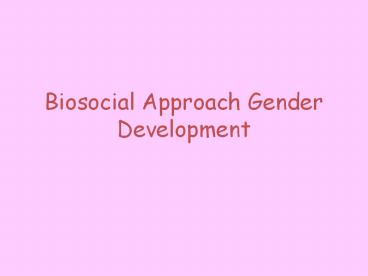Biosocial Approach Gender Development - PowerPoint PPT Presentation
1 / 15
Title:
Biosocial Approach Gender Development
Description:
Biosocial Approach Gender Development Gender Characteristics, whether biological or socially influenced, by which people define male and female Women Men Describe ... – PowerPoint PPT presentation
Number of Views:66
Avg rating:3.0/5.0
Title: Biosocial Approach Gender Development
1
Biosocial Approach Gender Development
2
GenderCharacteristics, whether biological or
socially influenced, by which people define male
and female
- Women
- Men
- Describe themselves in more relational terms
- Experience more relationship-linked emotions
- More empathetic
- Gravitate toward jobs that reduce inequalities
- Focus on tasks and on connections with large
groups - Respond to stress with fight or flight response
- Gravitate toward jobs that enhance inequalities
3
Division of labour
- Why are men seen as the breadwinners or hunter
gatherers? - Why are women often given the role of homemaker
and child minder? - Does our society today still benefit from gender
roles or is it becoming more similar?
4
Exceptions
Agta Tribe (Philippines) Aka Tribe (Africa) Dian
a Hunting Goddess
5
Women during the Wars
- Mechanics
- Engineers
- Tank drivers
- Building ships
- Working in factories - making bombs and aircraft
parts - Air raid wardens
- Driving fire engines
- Plumbers
- Ambulance drivers
- WRVS volunteers
- Nurses
6
Biosocial Theory
Parental expectations
Money and Ehrhardt (1972)
7
Social Role Theory
Eagly and Wood (1999)
8
What about sex differences in mate choice?
- Resources
- Domestic
- Compliment
- each other
9
- Gender and Mating Preferences
- Men seek out quantity
- Spreading genes widely
- Women seek out quality
- Protecting and nurturing of offspring
10
- Equal Pay
- Maternity cover
11
Hormonal differences
- Are these differences a cause or an outcome?
- Eagly and Wood (2002) hormonal differences may
be an outcome of social roles e.g. testosterone
as a result of engaging in more active and
competitive activities
12
- Gender and Hormones
- Gender gap in aggression seems influenced by
testosterone - As humans age they become more androgynous
- Mixing both masculine and feminine
characteristics
13
Social Constructionist Approach
- Eagly and Wood
- Human behaviour is mainly an invention or outcome
of a particular society or culture - Behaviours are best explained in the context in
which thy occur - Luxen (2007)
- High ethical appeal if sex roles are perceived as
more flexible
14
- Buss (1989)
- 37 cultures examined
- 10,000 people
- Women desire mates with good financial prospects
- Men placed more evidence on physical
attractiveness and youth- fertility and obedience - Both look for intelligence, kindness and
loyal/dependable - (supports evolutionary)
- Eagly Wood (1999)
- Used Gender Empowerment Measure
- When women had higher status (more equal)
mating preferences become less pronounced - Therefore social roles are driving force in
psychological sex differences
However, Gangestad et al (2006) Re-examined same
data Gender equality not related to sex
differences. Therefore evolutionary theory
better explanation
15
Culture
- Gender Role
- Set of behavior expectations (norms) for males
and females - Gender roles vary over culture
- Gender roles vary over time
- Peer-Transmitted Culture
- 50 percent of individual variations in
personality traits is by parental nurturing - The other 50 percent is peer influence

